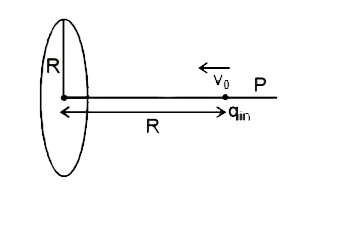Three identical particles with velocities v0ˆi, −3v0ˆj and 5v0ˆk collide successively with each other in such a way that they form a single particle. The velocity vector of resultant particle is
(a) v03(ˆi+ˆj+ˆk)
(b) v03(ˆi−ˆj+ˆk)
(c) v03(ˆi−3ˆj+ˆk)
(d) v03(ˆi−3ˆj+5ˆk)
The correct Answer is:D
p1=pf
∴m(v0ˆi)+m(−3v0ˆj)+m(5v0ˆk)
=3mv
∴v=v03(ˆi−3ˆj+5ˆk)
Topper's Solved these Questions
- CENTRE OF MASS, LINEAR MOMENTUM AND COLLISIONBOOK - DC PANDEYCHAPTER - CENTRE OF MASS, LINEAR MOMENTUM AND COLLISIONEXERCISE - Level 1 Subjective
32 Videos
- CENTRE OF MASS, LINEAR MOMENTUM AND COLLISIONBOOK - DC PANDEYCHAPTER - CENTRE OF MASS, LINEAR MOMENTUM AND COLLISIONEXERCISE - Level 1 Subjective Questions
1 Videos
- CENTRE OF MASS, LINEAR MOMENTUM AND COLLISIONBOOK - DC PANDEYCHAPTER - CENTRE OF MASS, LINEAR MOMENTUM AND COLLISIONEXERCISE - Level 1 Assertion and Reason
15 Videos
- CENTRE OF MASS, IMPULSE AND MOMENTUMBOOK - DC PANDEYCHAPTER - CENTRE OF MASS, IMPULSE AND MOMENTUMEXERCISE - Comprehension type questions
15 Videos
- CIRCULAR MOTIONBOOK - DC PANDEYCHAPTER - CIRCULAR MOTIONEXERCISE - Medical entrances s gallery
19 Videos
Similar Questions
Knowledge Check
Three particles with masses 10, 20 and 40gm are moving with velocities 10ˆi,10ˆjand10ˆk m/sec respectively. If due to some interaction the first particle comes to rest and the velocity of second becomes )(3ˆi+4ˆj) m/sec. then the velocity of third particle after the interaction is-
Aˆi+ˆj+5ˆkBˆj+10ˆkCˆi+ˆj+10ˆkDˆi+3ˆj+10ˆkTwo identical particles move towards each other with velocity 2v and v respectively. The velocity of centre of mass is
AVBV/3CV/2DZeroTwo identical particles move towards each other with velocity 2v and v, respectively. The velocity of the centre of mass is:
AvBv/3Cv/2Dzero
A particle of mass m1 moves with velocity v1 and collides with another particle at rest of equal mass. The velocity of the second particle after the elastic collision is
View SolutionTwo identical particles move towards each other with velocity 2v and v respectively. The velocity of centre of mass is
View SolutionConsider two particles of equal mass m. If one particle is stationary while the other collides with this particle obliquely with velocity v. Now, what is the angle between the velocity vectors of the two particles after the collision?
View SolutionA particular has initial velocity , v=3ˆi+3ˆj and a constant force F=4ˆi−3ˆj acts on it. The path of the particle is
View SolutionA particle of mass 15 kg has an initial velocity →vi=ˆi−2ˆjm/s . It collides with another body and the impact time is 0.1s, resulting in a velocity →cf=6ˆi+4ˆj+5ˆkm/s after impact. The average force of impact on the particle is :
View Solution

